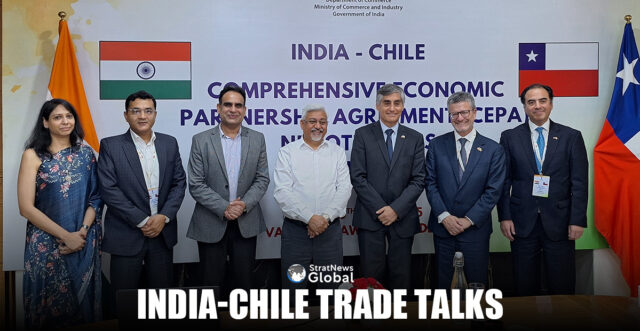In a major step towards deepening of economic ties between India and Chile, the first round of negotiations for a Comprehensive Economic Partnership Agreement (CEPA), have begun in New Delhi. These negotiations, according to officials, will focus on critical minerals, investment and expanding bilateral trade.
Talks that will be on till May 30 follow the formal signing of the Terms of Reference (ToR) on May 8 and reaffirm commitments made during the Chilean President’s state visit to India in April.
“The visit of President Gabriel Boric Font solidified years of growing collaboration and opened doors for future strategic cooperation,” Chilean Ambassador to India Juan Angulo told StratNews Global.
The CEPA seeks to build on the existing Preferential Trade Agreement (PTA) by including new areas such as digital services, investment facilitation, support for micro, small and medium-sized enterprises (MSMEs) and critical minerals. The upgraded agreement is anticipated to boost trade volume and broaden the export portfolio for both countries.
Critical Minerals And Electric Mobility
A central pillar of the CEPA discussions is enhanced cooperation in the critical minerals sector. Chile’s global leadership in lithium and copper production positions it as a vital partner for India’s transition to electric mobility and green energy. Indian companies are exploring investment opportunities in Chile’s mining sector, particularly in value-added processing for electric vehicle (EV) battery components.
Earlier this year, the two nations signed a Memorandum of Understanding (MoU) to deepen cooperation in this sector. “There is strong trust between our companies,” said Ambassador Angulo. “Indian businesses are looking to invest in Chile, especially in sectors like agro-products, mining technology and even manufacturing.”
Agriculture Has Room For Growth
Agricultural trade has emerged as a bright spot in India-Chile relations, with Chilean exports such as blueberries, avocados and apples gaining traction in the Indian market. The ambassador highlighted the two countries’ bilateral agricultural cooperation agreement, signed in 2023, which includes joint working groups and regular ministerial exchanges.
Chile, in turn, is open to Indian agricultural products. “We are open to Indian imports—rice, bananas, poultry—provided they meet our pricing and quality benchmarks,” Ambassador Angulo said.
Infrastructure, Renewable Energy And More
Chile is keen to invite Indian investment into infrastructure, ports and renewable energy. Meanwhile, India views the CEPA as a pathway to deepen its commercial footprint in Latin America’s second-largest trading partner. Indian exports to Chile include textiles, chemicals, automobiles, pharmaceuticals and electrical machinery.
The CEPA framework will aim to unlock new areas for sector-specific growth and supply chain integration, building on India’s rising trade with Latin America, which reached approximately US $2.45 billion with Chile in FY 2023–24.
Roadmap And Stakeholder Support
India-Chile CEPA negotiations are expected to continue through successive rounds, with both governments aiming to finalise the agreement by early 2026. Industry bodies are actively involved in supporting the talks—most notably the Bombay Chamber of Commerce & Industry and Chile’s SOFOFA that signed an MoU in April to offer technical input and help ensure the agreement’s successful implementation.
“This partnership is not just about trade—it’s about long-term strategic cooperation,” stressed Ambassador Angulo.
Background
The CEPA builds on a history of bilateral agreements, beginning with the Framework Agreement on Economic Cooperation in 2005 and the PTA in 2006, later expanded in 2017. With the current momentum, both countries appear poised to shape a future-oriented trade architecture aligned with shared priorities: clean energy, digital innovation, resilient supply chains and inclusive economic growth.





